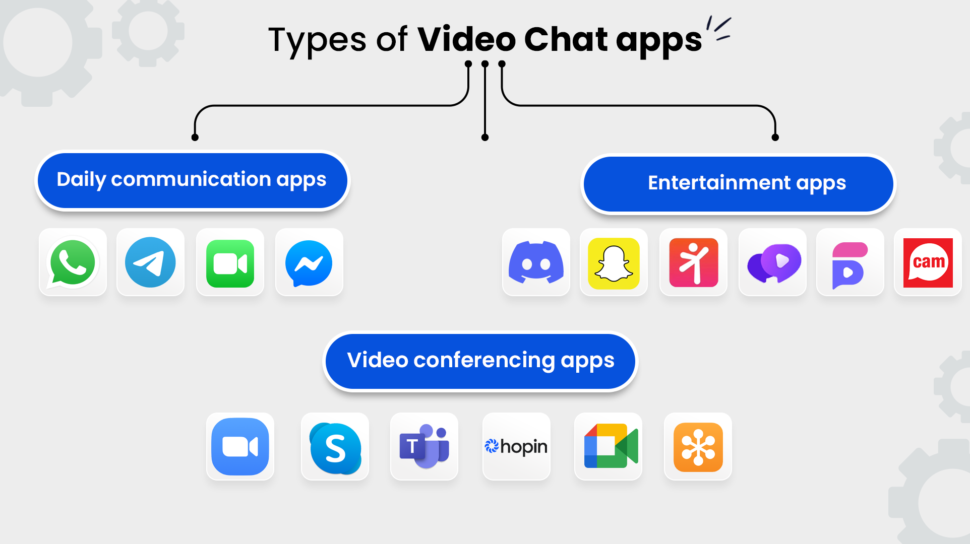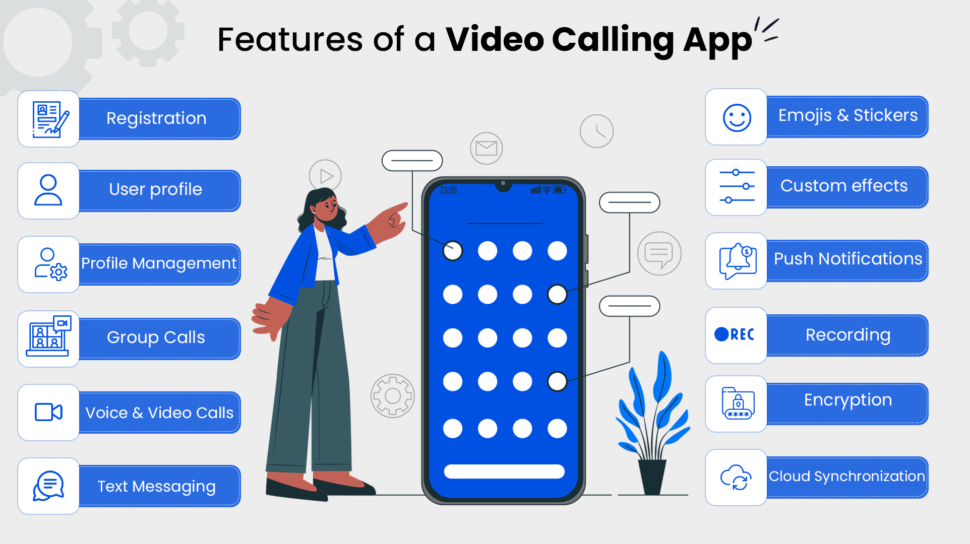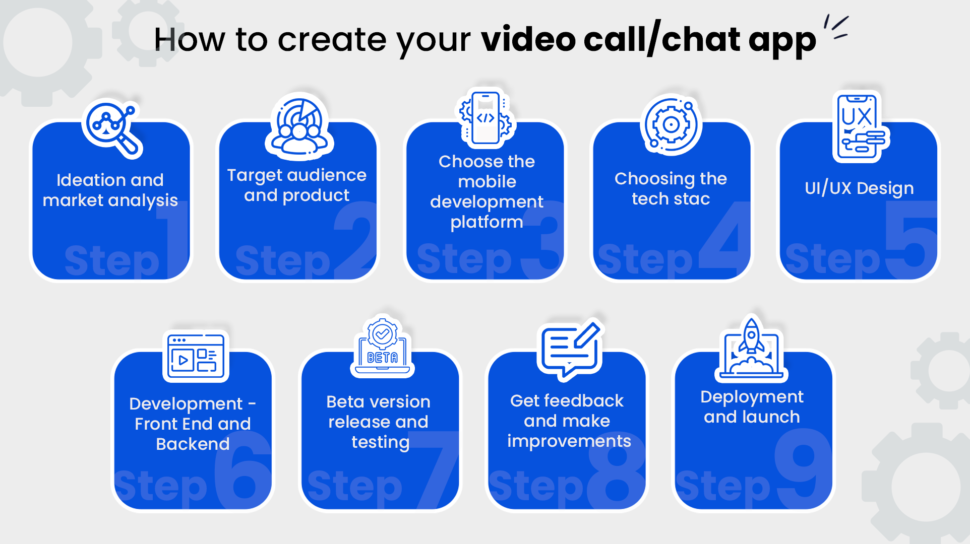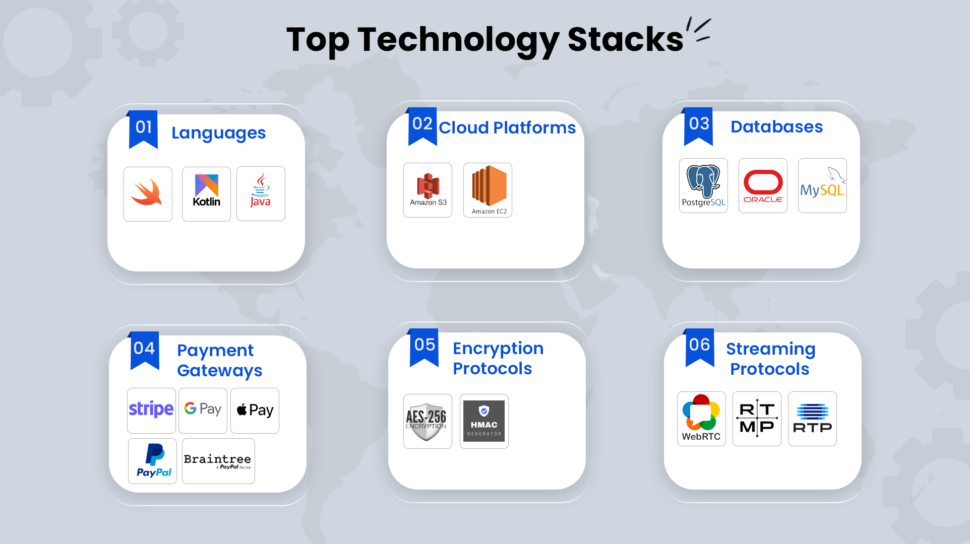Over the past few years, online messaging and video calls have become indispensable parts of our daily lives. Trends have shown a steady interest in video calls, with the popularity growing among millennials. As a result, online video calls have become a primary means of communication for personal and business-related communication.
With companies continuing to do remote work, the video-calling app development market is only expected to grow exponentially. According to Grandview Research, the video conferencing market is currently valued at $4.2 billion and is expected to reach $8.6 billion by 2027.
Studies also show how video apps help improve workflow, with many studies proving that –
- Video calls are the most preferred way to collaborate for more than 80% of employees.
- 89% of businesses use multiple video conferencing platforms.
- Zoom tops the list of video calling apps, closely followed by Teams and Webex.
- Video conferencing leads over other business technologies.
As a result, more and more companies want to grab a piece of the pie by integrating video and audio calling into mobile apps or wish to create new apps based on the technology. However, you must understand that only some apps get to be a smashing success, like Zoom, Google Meet, etc. and what differentiates them is a set of proper planning and research, which makes it easier to succeed in the saturated market.
So, in this blog, we’ll be sharing insights on how to gain a competitive edge while developing a video call/chat app and how it can be a great opportunity for your business. Furthermore, we will discuss in detail what it actually takes to create a video chat app, including the process, features, and tech stack, and how you can launch this new business.
Without further ado, let’s get started and first see the type of video chat apps and some examples before proceeding further on how to create a video call app.
Types of Video Chat Apps
Video chat or video apps are instant messengers with high-quality video calling and recording functionality. The most famous are Zoom, Google Duo, Microsoft Teams, Skype for corporates, Facetime, Whatsapp, Instagram, etc., for personal use.
The following are the types of video chat apps and how they differ in functionality.

1) Video conferencing apps
They help to conduct meetings and conferences online with as many visitors as possible. These apps cover most businesses and personal needs and are free to use till a specific limit. Additional options are available when companies subscribe to plans.
Examples: Zoom, Skype, Microsoft Teams, Hopin, Google Meet, Goto meetings, etc.
2) Entertainment apps
They are prevalent for covering personal needs and are rarely used for business. They have integrated into all spheres of our lives and can be used for communication with friends and family, or live video streaming to a certain segment of audience. GenZ significantly loves them.
Some examples include Discord, Snapchat, LiveFun, ChaLiv, BiLiv, CamChat, etc.
3) Daily communication apps
They are the most popular apps for personal use that can be used daily. Live video calls can be made between individuals and in a group setup.
Some examples include Whatsapp, Telegram, FaceTime, Facebook Messenger, etc.
Features to include in a Video Calling App
To make a video calling app, the following features are a must-have that you must know before you plan to wipe out the competition in the segment. Let’s take a look at them.

Registration
A simple and convenient registration can be an excellent way to welcome users. Giving them various sign-up options – through email and phone numbers can be good to start with. At this stage, your app must ask for permission to microphone, contact, and make phone calls.
User profile
After registration, the user profile is created with their data, image, avatar, status, and customization options. When they create a user profile, ensure you do not overload them with too much information, leave some data private, and have a status online/offline functionality.
Profile Management
Users will interact with each other, so develop simple permissions for chat room creators to have admin rights such as adding/removing members to calls, chat access, reactions, etc. In addition, for regular chat groups, advanced options can be provided for business members, like an HRBAC (Hierarchy role-based access control) and RBAC (Role-based access control).
Group Calls
This is a must-have feature for any live/video chat app, as users can create and invite users to groups for communication. On average, the conference call can help between 5 to 25 members over VoIP (Voice over Internet Protocol).
Voice and Video Calls
The essential feature of all. The app should enable a secure architecture for users to communicate with each other. Going by the current trend in the space, it would help to have a 100% encrypted setup to make calls and chat in the app.
Text Messaging
This can come in handy when the user wishes to convey something in writing or cannot hear one another in the call. Even though the core of your application is video calling functionality, it helps to add text chat as an option since the users don’t always want to get on a call.
Push Notifications
They notify users of missed calls or new chat messages. In addition, they keep users informed of all the latest updates and keep them engaged with the application.
Encryption
End-to-end encryption has been a must and a security standard in recent years. The messages are encrypted so that they cannot be read if the app is hacked, and the confidentiality of information is intact.
Cloud Synchronization
In case of any breakdowns, storing files on the cloud can help save data and maintain the app with all changes in the current state. Cloud also helps keep the app functionalities intact despite the poot connection.
Advanced Features
Emojis and Stickers
This personalization feature can be used in calls and messages to convey emotion and goes a long way toward a good user experience.
Custom Effects
New effects and filters are the order of the day. Have a vast library of effects, invest in personalization options, and the social experience of using your app goes up many notches.
Recording
These are essential features to include as it helps to record and save a meeting that a user cannot attend. They can save the recording to hear it later.
Cost of building the video chat app
The costs for a video chat app can depend on various factors such as team, platform, app features, developer/development company location, and expected deadlines. A video calling app needs the work of the following.
- Project manager
- Business analyst
- UI/UX designers
- Front-end developer
- Backend developers
- QA specialists
Know that a custom video app solution costs can be expensive depending on the work, the average cost for a video calling app can begin from $50,000 to $240,000.
The price depends on features and the time required for implementation. In the main iOS/Android development stage, it may take about 350-500 hours for MVP. The app web server creation and configuration will add about 10-200 hours.
| Stages | MVP | Full Feature |
| Business Analysis | 50-80 | 80-100 |
| UI/UX | 40-60 (each platform) | 80-120 (each platform) |
| iOS/Android Development | 400-450 | 600-700 |
| Backend | 200-300 | 400-500 |
| QA | 50-60 | 80-100 |
The following is the approximate cost budget for implementing the listed features in the section above on how to make a video chat app.
| Feature | Development Time | Cost ($50 an hour) |
| Registration | 80 | 4000 |
| User profile | 80 | 4000 |
| Profile Management | 25 | 1250 |
| Voice and Video Calls | 58 | 2900 |
| Group Calls | 52 | 2600 |
| Text Messaging | 100 | 5000 |
| Emojis and Stickers | 20 | 1000 |
| Custom Effects | 120 | 2000 |
| Push Notifications | 35 | 1750 |
| Recording | 50 | 2500 |
| Encryptions | 60 | 3000 |
| Cloud Synchronization | 650 | 32,500 |
The following is a rough estimate of the average costs of mobile video chats development in different countries –
| Country | Average hourly rate | App development cost |
| USA | $80 | $150,000-$250,000 |
| UK | $70 | $125,000-$170,000 |
| Western Europe | $65 | $120,000-$150,000 |
| Eastern Europe | $35 | $60,000 – $85,000 |
| India | $20 | $50,000 – $80,000 |

Now that we have looked into the feature sets, let’s get down to the details of how to create your own video calling app and the steps that go into them.
How to create your video call/chat app
To know how to create a video chat app, we have compiled the crucial steps you need to know before launch. As the process is complex and demands expertise from the right development team, here are the specifics you must know.

Step 1: Ideation and market analysis
You have decided to create a video chat app. First, you must conduct proper research and a thorough market analysis. Research potential competitors, their market share, and how they are faring. Once you do an accurate analysis, you can proceed to the next step, finalizing the target audience and product strategy.
Step 2: Target audience and product strategy
Understanding who your consumer is essential as it helps you understand which features you must include in the app. You must know their needs in the first place and design your product accordingly. Then, divide them into groups of interest and strategize.
Next is product strategy, which covers your app’s technical and other aspects. Finally, contact an excellent mobile app development company for good business analysis, technical specifications, and a roadmap as part of the app development process for video chat app development.
A roadmap helps you decide on the features to include in the video chat software project’s progress as per months or deadlines that must be observed strictly.
At Ailoitte, we pay close attention to-
- Project planning and features implementation
- Embracing client feedback
- Planning future updates
- Less turnaround time for the app
- Bug Fixes, and support post-launch
Step 3: Choose the mobile development platform
Android and Apple are the dominating platforms in the market, and you must consider their pros and cons before choosing either. Also, you can consider building a simple video chat web app like Google Hangouts, Skype, etc., that can be integrated with existing products or apps.
Pros of having an Android app
- It can work on many devices, giving you access to a vast target audience. You can use different channels to increase sales and make profits.
- You can release your app faster on Google Play as it dominates in both numbers and number of downloads.
- Finding Android developers is easy and lowers the entry threshold for enthusiasts.
- Google support is tremendous, and your app has complete advantages over competitors, traffic, and many channels owing to simple integration with other Google products and services
Cons of Android app development
- Owing to Android being open-source, security issues may be a cause of concern despite security updates from Google constantly. Therefore, additional measures for security must be taken into account.
- Customization of the app can be complicated owing to different OS versions that come with different software and hardware options.
- Statistics show that the Android app store gains as much as 60% from in-store purchases. Also, users are reluctant to pay for apps; therefore, you must look for other monetization ways.
Pros of creating an app for iOS
- Apple supports hardware and software optimization, and apps can be developed with high standards of performance and UI/UX requirements.
- Security standards are high, with constant patches being released from time to time to protect from phishing and hacking.
- Easier to write and test apps owing to minimal differences in OS versions.
Let us now look at the cons of iOS
- A lengthy review process of new apps compared to Google Play
- Large app sizes and developers must optimize it from time to time
- Customization is limited; designs must be set in a standardized format
Step 4: Choosing the tech stack
The following is the appropriate tech stack if we want to know the various technologies used in developing a video calling app

Please note that the tech stack will depend on the features you need and the platform you choose to launch your app.
Step 5: UI/UX Design
This is a crucial phase where visual, look and feel aspects are decided – from color schemes used in the shapes to the distances between the icons and the user journey. The UX is responsible for the login and intuitiveness in the app design, and UI is responsible for the visual aspects. Therefore, when you build a video calling app, it is essential to consider both elements. You must make the app’s interface noticeable and usable so that users like it.
We recommend testing multiple themes and colors behind the app screen, testing themes, and backgrounds, ensuring icons do not merge against a white backdrop, taking care of gradient hover, darkening the player’s lower block, etc.
Article recommended for you: Wireframe vs Mockup vs Prototype – A detailed comparison
Step 6: Development – Frontend and Backend
With the exterior design done, it is time to begin video call app development – the app frontend consists of the user interface code, and the backend consists of the database and web server. These are the core components of the app which need optimization.
The app must withstand the load of thousands of simultaneous video calls. This calls for powerful hardware, web, and app server components with excellent computing power. Choosing the right tech stack discussed above affects the app’s overall performance. We have experienced developers on board at Ailoitte who impact code optimization.
Step 7: Beta version release and testing
Depending on the app functionality, the tests can be carried out in a phased manner to monitor the output and carry out changes immediately. For example, carry out the following tests.
- Smoke testing: Basic testing
- Retesting: Fixing bugs and various improvements
- Regression Test: Large-scale tests carried out after changing the code or functionality
- Performance Testing: The app’s stability and responsiveness during internal operations
You can also use mobile test management systems like Jira, QA Touch, Testlink, etc., to speed up the process.
Step 8: Get feedback and make improvements
After the beta version of the release, collect feedback from end-users based on which the developers can make changes to the product. Then, be it improvement or implementation of new features, every aspect of user acceptance forms a part of the software testing time. This is the stage where the A/B test is conducted and helps you determine how the audience will react toward your app.
Step 9: Deployment and launch
After making all the changes in the beta version, the final stage begins for the app’s release. It consists of deployment on the web server and app stores. Now you need many servers to handle the high-level performance of your video calling app. In addition, a load balancer can be deployed in case of loss of time or quality differences in the video.
Moreover, your app must comply with platform requirements during launch, which may take time to get live.
Adhering to the steps above can help you in the release of the video chat app successfully. It is only a matter of time before you gain profits and strengthens your app from time to time with the proper updates. Also, the video chat app for Android and iPhone can be built as a separate standalone application per business needs or integrated into an existing communication platform.
Now that you know how to make a video calling app let us find out how Ailoitte can help you with video call app development.
How Ailoitte can help create a video chat/call app
We are an experienced end-to-end mobile app development company that develops custom app development solutions for businesses of all sizes. Our specialists at Ailoitte have extensive experience in developing video chat apps and other communication products. We have gained extensive experience working on real-time products from scratch and ensuring quality is maintained at all stages of development.
We recently worked on an app called Stargaze, an AI-based Interactive Celebrity-Fan engagement app in India. They offered digital engagement by enabling fans to connect with their favorite celebrity and buy exclusive passes. Stars could connect with fans who won through one-to-one video slots in a controlled, safe environment. We built a customized app for all their requirements and released the MVP in 45 days.
Similarly, we have helped entrepreneurs and startups build MVPs for multiple domains and helped established businesses add video chat to existing platforms to improve user experience.
If you need support on how to build a video chat app, feel free to contact us.
FAQs
Depending on the work, the average video-calling app development cost can start from $50,000 to $240,000.
To build a video chat app, firstly, you must research the users you wish to target and analyze the costs and investment needed. Then you must decide if you want to build a chat engine from scratch or use a ready-made API. Next, finalize the technology and frameworks you will be using and what your user interface will look like. Finally, build, test, gather feedback and then deploy the app to respective app stores.
To build a video chat app like Zoom, you must conduct a proper market analysis and find the target audience. Then create a fantastic UI/UX design for users and begin the app’s development. Choose the tech stack depending on the platform you are targeting and build the app’s front and back end depending on the features. Then test the app and gather feedback.
A chat app can cost anywhere from $30,000 to up to $150,000, depending on the features you wish to include and the platforms it needs to support.



















.png)
.png)
.png)



Leave a Comment